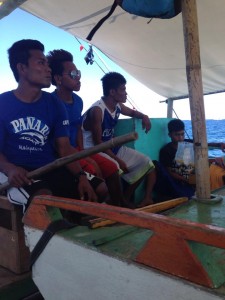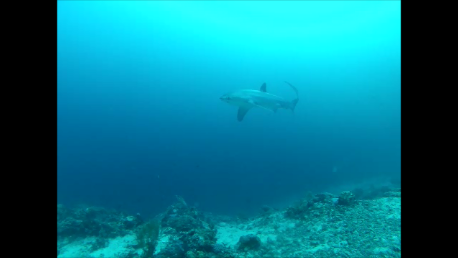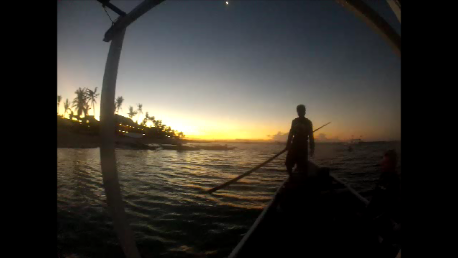At first glance it is hard to fathom that just last November one of the strongest typhoons to ever hit any continent occurred on this island nation of 7,100 islands in the Philippines. As I head towards the low laying islands, the destruction became more evident as I watched construction workers rebuild amid the deformed coconut trees stripped bare of limbs and leaves. As a scuba diving enthusiast, one of my greatest concerns was the island of Malapascua. Just two years earlier I had visited the area hoping to dive with the thresher shark, as this area is unique for frequent sightings. At the time, I was unable to make this dive due to unfavorable weather conditions and I had hoped to return one day. After Typhoon Haiyan occurred in late 2012, I had heard stories of the island diving community submerged by large surges and buildings that were demolished by winds up to 250 miles per hour. It became my obsession to see what happened to this island community and the world-class dive site that offered a chance to dive with the elusive thresher shark.

After a 19 hour flight, a 4 hour bus ride, and 1 hour banka boat ride, I could finally see the island. I was excited as we sailed through the island’s turquoise clear waters, which were as calm as a lake with white coral beaches. The stories I had heard about the effects of the storm were not exaggerated. Although the south and west side of the island were protected from the storms, the east side remained a catastrophic area. Homes remained bare of walls and were merely comprised of the foundation of the buildings beneath rubble. Boats damaged by the storm lay beached. I spoke to one of the local dive instructors in the area who explained to me that most of the people lacked funds to rebuild their homes and shops. Those who were fortunate enough to rebuild began construction immediately after relief was given to this small community. Several dive shops quickly reopened, as diving was the primary funding for this community. The island community hoped that divers would return to revitalize the island. However, the scuba diving industry remains fully affected by the typhoon, as waves significantly ruined part of the coral reefs. In addition, dynamite fishing and poaching of the hammerhead and thresher sharks continue to affect the dive sites in this area. Amid all of the problems this small island faces, it did not fail to deliver one of the greatest dives of my life.
———————————————————————————————————————————————————————–
Photos and story by Francis Antigua
———————————————————————————————————————————————————————–
 After a brief introduction to the dive site, I was taken on a deep scuba dive approximately 30 meters (about 99 feet) where we waited patiently beside a slope that quickly dropped hundreds of meters to the ocean floor. Known as Monad Shoal, this small area off the Marikana trench hosts an area for deep-water fish to cleanse themselves from parasites. A symbiotic relationship exists between the cleaner fish and the thresher sharks that ascend from the depths just after sunrise. As we dove into the clean blue waters, we were immediately greeted by Manta rays at the surface. Our luck would not end there. As we reached our targeted destination I could see a silhouette in the distance. It was the shark I’d been waiting for. After waiting a few more minutes he was joined by several more sharks. I counted five sharks within my area, but I am certain several more were spotted from other dive sites. The shark came within a meter (3 feet) of me: Majestic in appearance, slowly waving that long tail, and watching me with its large round eyes. No words could describe the experience I felt underwater, other than perfect.
After a brief introduction to the dive site, I was taken on a deep scuba dive approximately 30 meters (about 99 feet) where we waited patiently beside a slope that quickly dropped hundreds of meters to the ocean floor. Known as Monad Shoal, this small area off the Marikana trench hosts an area for deep-water fish to cleanse themselves from parasites. A symbiotic relationship exists between the cleaner fish and the thresher sharks that ascend from the depths just after sunrise. As we dove into the clean blue waters, we were immediately greeted by Manta rays at the surface. Our luck would not end there. As we reached our targeted destination I could see a silhouette in the distance. It was the shark I’d been waiting for. After waiting a few more minutes he was joined by several more sharks. I counted five sharks within my area, but I am certain several more were spotted from other dive sites. The shark came within a meter (3 feet) of me: Majestic in appearance, slowly waving that long tail, and watching me with its large round eyes. No words could describe the experience I felt underwater, other than perfect.

As we headed back to the dive shops, the divers exchanged stories of how great our day was. Several other divers immediately signed up for another dive in the area. As a diver, I am always excited to see such beauty within nature. I hope that the scuba diving community continues to support this small island community. All divers should visit the Philippines. Other than the sharks in Monad shoal, just a few hours away lies Moalboal, one of the most bio-diverse marine ecosystem and Oslob, home of the whale sharks. There is no doubt that I will continue to return to this island nation to explore its depths in its pristine state.
—————————————————————————————————————————————————
Photos and story by Francis Antigua, Independent Contributor
—————————————————————————————————————————————————
